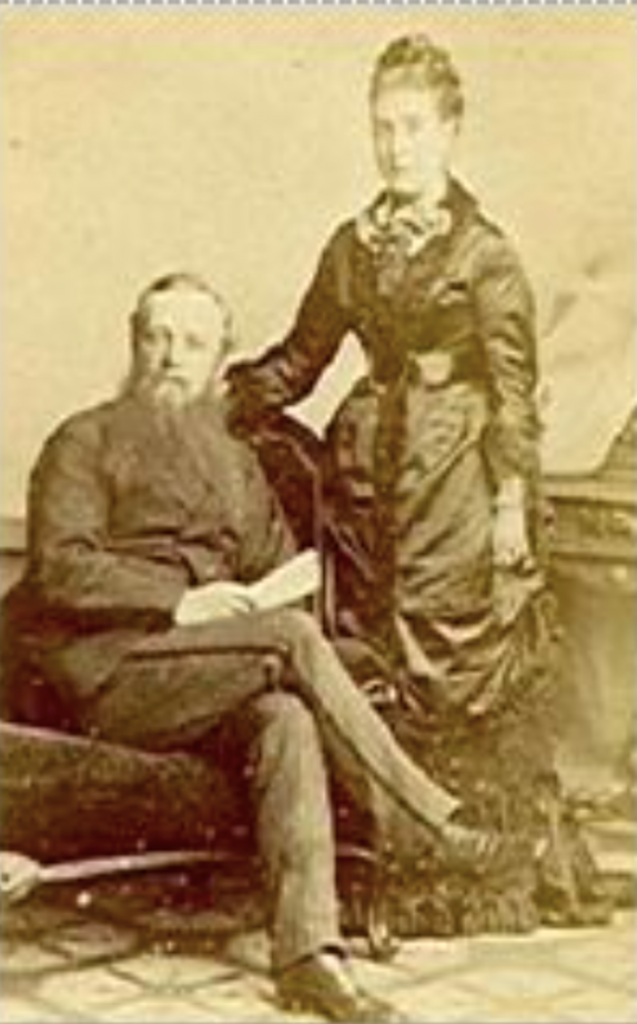
James Henry Matthews was born in London on 18 July 1839. He was the son of Christopher John James Matthews and his wife Mary Ann Bailey.
James Henry became a banker working for Grindlays and Company, based in England and India, where he worked during the Indian Mutiny in 1857. He worked for the firm for seventy years, rising to the position of Senior Partner before retiring on its amalgamation with the National Provincial Bank in 1923.
On his return to England he married Sarah Julia, daughter of Henry Stuart, on 8 August 1867 at Holy Trinity Church, Twickenham and they raised two daughters and four sons: Maude Stuart, Edith Mary, Victor Henry, Eric Stuart, Harold Laurence and Trevor Jocelyn. Trevor became an MP, was knighted and was a senior Freemason and would follow in his father’s footsteps and be a member of the Board of General Purposes.
By 1869 he was living at 55 Parliament Street, London and was working as an army agent. He became a Governor of Christ’s and the Foundling Hospitals and had connections with the British Orphan and Infant Orphan Asylums and other charitable institutions.
He was initiated in India on 14 December 1860 in Lodge Star in the East, No 80 (now No 67), Calcutta, India, where he was passed on 23 January and raised on 27 February the following year. He became a joining member of Industry and Perseverance Lodge, No 109, Calcutta in 1864, where he served as Worshipful Master in 1866. He was exalted in Holy Zion Chapter No 486 Calcutta on 15 February 1862. He served as District Grand Deacon of Bengal in 1868.
Returning to London he joined a variety of Lodges: Victoria Rifles Lodge No 822 in 1869; Middlesex Lodge No 143 in 1871, where he served as Worshipful Master in 1879, Secretary from 1880 to 1888 and Treasurer from 1888 to 1892. Methuen Lodge No 631 where he served as Worshipful Master in 1883; Drury Lane Lodge No 2129 in 1890, where he served as Secretary until 1897 and Royal Alpha Lodge No 16 in 1903.
He became a Founder of Captain Coram Lodge No 2737 in 1898, a lodge associated with the Foundling Hospital. He was appointed Grand Standard Bearer by the United Grand Lodge of England in 1884 and Past Grand Director of Ceremonies in 1890. He became a member of the Board of General Purposes and served as President of the Board of Benevolence from 1896 to 1906.
He became a joining member of Mount Moriah Chapter No 9 in 1880, where he served as First Principal in 1885. He was appointed Grand Director of Ceremonies by the Supreme Grand Chapter of Royal Arch Masons of England in 1884 and Past Grand Scribe N in 1916.
He was advanced in Carnarvon Lodge, No 7 on 23 March 1882. He became a joining member of Ruspini Lodge No 363 where he became a Past Master. He was appointed Assistant Grand Director of Ceremonies by the Grand Lodge of Mark Master Masons of England and Wales and its Districts and Lodges Overseas in 1889 and Grand Junior Overseer in 1892.
He was installed as a Knight Templar in Sepulchre Preceptory, No 27, Calcutta on 7 June 1866. He became a joining member of Faith and Fidelity Preceptory, No 26 in 1882, where he served as Eminent Preceptor in 1890.
In the Ancient and Accepted Rite he was perfected in Grand Metropolitan Chapter No 1 on 1 April 1877, where he became a Past Most Wise Sovereign. He was awarded 33º in 1891. He became Director of Ceremonies of the Supreme Council in 1890, serving for four years. He served as Inspector-General of the South East District from 1891 to 1925; Grand Treasurer General from 1912 to 1925 and Grand Chamberlain.
He became a member of the Royal Order of Scotland.
He supported the three Masonic charitable Institutions and served as a member of the Royal Masonic Institution for Girls from 1882 until his death. He became a Gold Medallist of the Masonic Million Memorial Fund, formed in 1919 to raise money to construct the new United Grand Lodge of England’s Freemasons’ Hall, Great Queen Street, London.
He died on 9 September 1928.